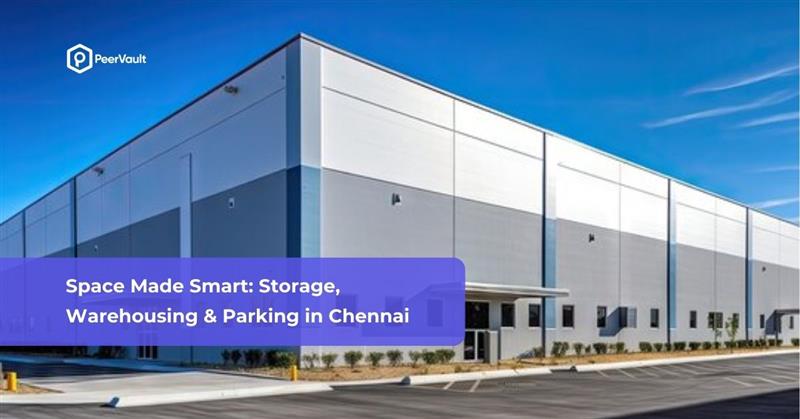Space Made Smart: Storage, Warehousing & Parking in Chennai

Chennai, the capital of Tamil Nadu, has become a key center for logistics, warehousing, and urban development in India. Its strategic coastal location, strong industrial foundation, and growing urban population have significantly increased the demand for efficient space utilization, particularly for storage, warehousing, and parking. As the city continues to expand, managing space effectively has become crucial to accommodate both businesses and residents. The need for innovative solutions to address these growing demands is more pressing than ever. This article explores the current trends, challenges, and technological advancements shaping space management in Chennai, highlighting how the city is adapting to these demands. With a focus on self-storage, warehousing growth, and parking solutions, the article examines how these industries are evolving to meet the city’s needs while ensuring sustainable development and improved efficiency for both businesses and individuals in Chennai.
1. The Evolving Landscape of Storage in Chennai
1.1 Rise of Self-Storage Solutions
Self-storage, a relatively new concept in India, has been gaining significant popularity, especially in metropolitan cities like Chennai. The increasing demand for storage solutions can be attributed to several factors that reflect the changing dynamics of urban living.
One of the primary drivers is urbanization. As Chennai continues to attract people from all over the country for work, education, and better opportunities, living spaces have become increasingly compact. The surge in population and the rising cost of living have made it difficult for people to afford larger homes. Consequently, many residents are turning to external storage options to store their belongings, which may not fit in their homes but are still important to them. This trend has fueled the need for self-storage facilities in the city.
Another contributing factor is the shift in lifestyle choices. With the growing popularity of minimalistic living and the decluttering movement, people are more inclined to keep only the items that serve them in the present, while storing seasonal goods, memorabilia, or infrequently used items elsewhere. This lifestyle change has led to a growing demand for easily accessible and secure storage spaces.
Additionally, business needs play a crucial role in the rise of self-storage solutions. Small and medium enterprises (SMEs) often struggle with the high costs of commercial storage or warehousing. For these businesses, self-storage units provide an affordable, flexible, and scalable option to store inventory, documents, and equipment, offering a much-needed solution in a competitive market.
1.2 Peer-to-Peer (P2P) Storage Platforms
The advent of Peer-to-Peer (P2P) storage platforms, such as PeerVault, is revolutionizing the storage industry. These platforms connect individuals with unused storage spaces to those seeking secure and affordable storage solutions. The benefits of P2P platforms are manifold:
- Cost-Effectiveness: By utilizing available unused spaces, P2P platforms allow users to find storage options at lower prices compared to traditional self-storage facilities. This makes it a highly affordable option for individuals and businesses alike.
- Flexibility: P2P storage platforms offer a wide range of choices in terms of storage size, duration, and location. Whether someone needs temporary storage while moving or long-term space for seasonal items, P2P platforms cater to various needs and preferences, giving users more control and options.
- Community Engagement: These platforms encourage a collaborative, sharing economy by fostering trust among users. People can rent out their extra space, making better use of their resources while helping others. This also builds a sense of community and shared responsibility, promoting a more sustainable way of utilizing available space.
Through these innovative approaches, P2P storage platforms are transforming the way storage is accessed and managed, offering practical solutions in the urban landscape of Chennai.
2. Warehousing: Chennai’s Industrial Backbone
2.1 Growth Trajectory
Chennai’s warehousing sector has experienced substantial growth over the years, driven by a combination of strategic advantages and evolving market dynamics. The city’s proximity to major ports, such as the Chennai Port and Ennore Port, alongside its robust road and rail network, has positioned it as a prime location for logistics operations. This connectivity is crucial for businesses that rely on efficient distribution networks to move goods domestically and internationally.
Additionally, Chennai’s industrial growth has been a significant factor in the rise of warehousing demand. The city is home to several key industries, including automotive, electronics, textiles, and manufacturing. As these industries continue to expand, their need for warehousing space to store raw materials, finished goods, and spare parts increases. Chennai has emerged as a manufacturing powerhouse, with companies looking to streamline their supply chains through strategic warehousing solutions.
The rise of e-commerce has also played a pivotal role in this growth. With the growing popularity of online retail platforms, there has been an escalating demand for efficient and large-scale distribution centers. E-commerce giants require state-of-the-art warehousing facilities equipped with the latest technologies to manage inventory and ensure timely delivery. This sector alone has become one of the driving forces behind the demand for modern warehousing solutions in Chennai.
2.2 Key Statistics
In 2024, Chennai witnessed an industrial and warehousing space absorption of 5.0 million square feet, an increase from the 4.5 million square feet absorbed in 2023. This growth reflects the increasing demand for storage and distribution facilities within the city as both industrial and commercial sectors continue to expand.The manufacturing segment emerged as the largest contributor, accounting for 43% of the total absorption, driven by the automotive, electronics, and textile industries. Following closely is the third-party logistics (3PL) segment, which made up 31% of the total absorption. These segments have become critical to Chennai’s warehousing landscape, with 3PL providers offering end-to-end supply chain solutions, including storage, inventory management, and distribution. This growth trajectory is expected to continue as Chennai solidifies its position as a central hub for both industrial and e-commerce-related warehousing.
2.3 Challenges and Opportunities
Challenges:
- Land Acquisition: The high cost and complex procedures involved in acquiring land for warehousing facilities pose significant barriers to rapid development in Chennai.
- Infrastructure Gaps: There is a pressing need for better last-mile connectivity and reliable power supply to support efficient logistics and warehousing operations.
Opportunities:
- Government Initiatives: The Indian government has introduced several policies aimed at enhancing infrastructure and making it easier for businesses to set up operations, providing a favorable environment for warehousing growth.
- Technological Integration: The adoption of advanced technologies like automation and IoT can streamline warehouse operations, improving efficiency in inventory management and distribution, thus driving growth in the sector.
3. Parking Solutions: Addressing Urban Congestion
3.1 The Parking Predicament
Chennai’s rapid urbanization has significantly contributed to the growing parking challenges in the city. One of the primary issues is the proliferation of private vehicles. With the city’s expanding population and increasing disposable incomes, more residents are opting for personal vehicles, leading to a sharp rise in the number of cars on the road. However, this surge in vehicles has not been met with an adequate increase in parking infrastructure, resulting in a severe parking crunch, particularly in commercial and residential areas.
Moreover, traffic congestion has worsened due to the lack of designated parking spaces and the widespread practice of illegal parking. Motorists often park vehicles on roadsides, blocking traffic flow and contributing to bottlenecks. This, in turn, exacerbates the city’s already congested streets, further affecting the overall traffic conditions. As the demand for parking spaces continues to outpace supply, the city’s infrastructure is under increasing pressure.
3.2 Innovative Parking Solutions
To tackle the parking dilemma, innovative solutions are being implemented across Chennai. Multi-level parking facilities have become an effective way to maximize space in high-demand commercial areas. These vertical parking structures offer a much-needed solution in congested zones where horizontal space is limited, allowing for the accommodation of more vehicles within a smaller footprint.
Additionally, smart parking systems are revolutionizing the way people find parking spaces. These systems use sensors and mobile applications to help drivers locate available parking spots in real time, reducing the time spent searching for parking and alleviating congestion.
Furthermore, Peer-to-Peer (P2P) parking platforms have emerged as a popular solution, enabling individuals to rent out their unused parking spaces. These platforms not only optimize the use of existing spaces but also provide an additional source of income for property owners, contributing to more efficient space utilization.
4. Integrating Technology for Smart Space Management
4.1 Role of Technology
Technology plays a pivotal role in transforming the warehousing, storage, and parking industries, enhancing both operational efficiency and user experience. One of the most significant technological advancements is data analytics, which leverages predictive analytics to forecast demand and optimize inventory management. This enables businesses to maintain optimal stock levels and ensure that goods are available when needed, reducing the risk of overstocking or stockouts.
Another key innovation is automation, particularly the use of automated guided vehicles (AGVs) and robotics in warehouses. These technologies streamline the movement of goods within warehouses, reducing the need for manual labor and speeding up operations. AGVs can transport items across vast warehouses, minimizing human error and improving overall throughput.
Additionally, the rise of mobile applications has revolutionized user interaction with storage and parking services. These user-friendly apps allow customers to easily book storage units or parking spaces on-demand, improving accessibility and convenience. The integration of technology into these services not only makes it easier for users to manage their space requirements but also increases transparency in the process, with real-time updates on availability.
4.2 Benefits
The integration of technology brings several key benefits to both businesses and users. Efficiency is significantly enhanced, as automation and data-driven decisions streamline operations, reduce manual intervention, and minimize errors. This results in faster, more accurate processes across warehousing, storage, and parking systems.
Cost savings are another major benefit. By optimizing resource utilization, companies can lower operational costs, reduce waste, and achieve better space management.
For end-users, the biggest advantage is an enhanced user experience. With greater convenience, transparency, and ease of access, customers enjoy a seamless process, whether booking a storage unit or finding a parking spot, leading to increased satisfaction and loyalty..
5. Environmental and Sustainability Considerations
Green Warehousing and Sustainability
Green warehousing focuses on reducing environmental impact by incorporating energy-efficient systems like LED lighting, solar panels, and smart climate control to minimize energy use. Additionally, using sustainable building materials such as recycled steel and eco-friendly insulation helps reduce the environmental footprint of warehouse construction.
Another key aspect is the reduction of carbon footprint. Optimizing logistics and storage minimizes unnecessary transportation, cutting fuel consumption and lowering greenhouse gas emissions. Efficient route planning, consolidating shipments, and using eco-friendly vehicles further reduce emissions, while also improving supply chain efficiency and reducing costs.
Incorporating green spaces into urban planning and infrastructure is becoming a priority. Developers are increasingly focusing on integrating nature into warehouse designs to promote biodiversity, reduce the heat island effect, and improve the quality of life in urban areas. This sustainable approach in infrastructure development benefits both businesses and the environment, ensuring long-term, eco-friendly growth.
FAQs
1. What is the demand for storage and warehousing in Chennai?
Chennai’s strategic location and rapid industrial growth have increased the demand for storage and warehousing. Industries such as automotive, electronics, and e-commerce require efficient spaces to store goods, contributing to the rise in warehousing needs.
2. How are technology and automation changing the warehousing industry in Chennai?
Technology is revolutionizing warehousing in Chennai through automation, IoT, and data analytics. These innovations improve inventory management, optimize space utilization, and streamline operations, resulting in cost savings and improved efficiency.
3. What are the benefits of multi-level parking solutions in Chennai?
Multi-level parking structures help address the city’s parking shortages by maximizing vertical space, especially in high-density commercial areas. These systems alleviate traffic congestion and reduce the pressure on existing parking spaces.
4. How can Peer-to-Peer (P2P) parking platforms help in Chennai?
P2P parking platforms allow individuals to rent out their unused parking spaces, optimizing the available parking stock. This helps alleviate the city’s parking woes, especially in congested areas, and provides additional income to property owners.
5. What are the government initiatives supporting warehousing and logistics in Chennai?
The Indian government has introduced various policies, including the implementation of logistics parks and the promotion of infrastructure development. These initiatives aim to enhance ease of doing business and streamline supply chain management.
6. What are the environmental benefits of green warehousing?
Green warehousing incorporates energy-efficient systems and sustainable materials to reduce the carbon footprint. This includes reducing energy consumption, optimizing logistics, and integrating eco-friendly building designs to promote sustainability in the industry.
7. How can businesses in Chennai benefit from adopting smart parking systems?
Smart parking systems in Chennai use sensors and mobile apps to guide drivers to available spots, reducing the time spent searching for parking. This not only enhances the user experience but also helps reduce traffic congestion and improve urban mobility.
Conclusion
Chennai is on the brink of a transformative shift in space management. With growing demands in storage, warehousing, and parking, the city is exploring innovative solutions to ensure efficiency and sustainability. Embracing technology-driven, community-centric platforms like PeerVault highlights the potential to revolutionize how space is utilized in urban areas. By leveraging smart, scalable solutions, Chennai can optimize its space usage while addressing the challenges posed by rapid urbanization. These advancements not only enhance operational efficiency but also contribute to creating a more sustainable, accessible urban environment. As the city continues to evolve, innovative approaches will be key to managing its growing demands and ensuring a balanced, sustainable future.
Popular Posts






